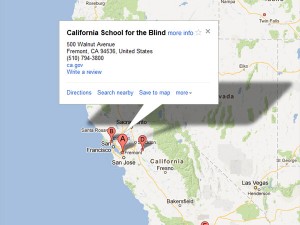Blind tennis players keep their ears on the ball

That’s what students are doing at the California School for the Blind. They’re learning a form of tennis adapted for the visually impaired — and expanding the boundaries of what the blind can do.
The state-supported campus in Fremont is one of three American schools for the blind that recently began teaching adapted tennis, which was invented in Japan in the 1980s. A non-profit group called Tennis Serves is working to promote the sport throughout the U.S.
“I didn’t know someone with no vision could play tennis until I came to this school,” said a 16-year-old student from Modesto named Jonathan. The school declined to provide his last name, citing a state law that protects the privacy of students with disabilities.
Blind tennis features a smaller court, lower net and junior tennis rackets with bigger heads and shorter handles. String is taped to the floor so players can feel the boundaries with their feet.
Players use a foam ball filled with metal beads that rattle on impact, allowing them to locate the ball when it hits the ground or racket. Once served, they have to return the ball before it bounces three times.
“The most difficult thing to teach is timing their stroke,” said Sejal Vallabh, the 17-year-old founder of Tennis Serves. “Being able to listen to the ball, locate it using their sense of hearing and swing at the precise moment the ball goes by is really difficult to teach.”
While experienced players can keep the ball in bounds and stage extended rallies, just hitting the ball over the net can be a challenge for beginners. During a recent visit to the California School for the Blind, students mostly swatted balls into the ground, the net and toward the ceiling and walls. Few balls were returned, but teachers say some are developing that capability.
Blind tennis was created in 1984 by Miyoshi Takei, a blind Japanese high school student who designed the adapted ball and helped the sport gain popularity in Japan and other Asian countries. He dominated blind tennis competitions until he was killed in a train accident last year at age 42.
Vallahb, an avid tennis player who is now a high school senior in Newton, Massachusetts, first encountered blind tennis two years while doing a summer internship in Japan, where her grandmother lives.
“After I saw it there, I knew that I wanted to recreate the sport that I had seen back in the U.S.,” she said, so she started Tennis Serves.
Vallabh first began teaching at Perkins School for the Blind in Watertown, Massachusetts with help from her high school tennis teammates. She then helped start similar programs at Lighthouse International in New York City and the California School for the Blind.
Vallabh is working with engineering students at Harvey Mudd College in Claremont, California to design a ball that continuously beeps to make it easier for blind players to track it.
At the California School for the Blind, staff members said they were skeptical when Vallabh first approached them about teaching the adapted sport.
“We were thinking, ‘How are we going to teach tennis?'” said Mary Alice Ross, who teaches adapted physical education. “My colleague said, ‘Tennis is like teaching football. It’s not something we really do.'”
The California School for the Blind, which has about 90 students ages 5 to 22, offers many adapted sports activities and sports, including bowling, boating, swimming, hiking, ice-skating and goal-ball.
Tennis is one of the most difficult sports for the visually impaired, but it brings unique rewards, teachers say.
“When it comes to being able to play a sport which is commonly only played by people with good vision, it’s a big self-esteem boost.” said John Healy, a dorm counselor who teaches adapted tennis.
A 12-year-old student named Sebastian said he was surprised when he first heard about the adapted sport.
“Tennis? How could blind people play tennis?” he said. “But then I was like, blind people can do anything they want. If you set your mind to it, then you can do it.”